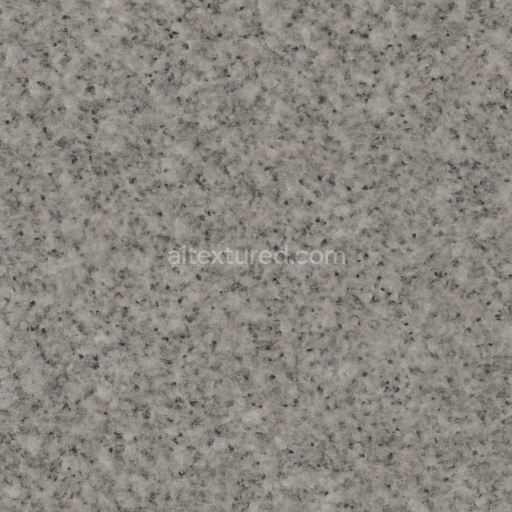This seamless 8K 3D texture showcases a granite surface characterized by intricate rough crystalline details and natural speckling, reflecting the authentic appearance of coarse mineral grains and subtle color variations found in real granite stones. The base substrate is composed primarily of interlocking quartz, feldspar, and mica minerals, which contribute to the stone’s unique structural composition and inherent durability. Variations in mineral grain size and orientation create a dynamic surface texture that transitions naturally between matte and polished stone finishes, simulating the weathering and polishing processes typical of granite in architectural and landscaping applications. The texture’s fine mineral inclusions and natural pigments are faithfully captured in the BaseColor/Albedo channel, delivering realistic color depth and irregularities.
In the PBR material setup, the Normal map emphasizes the rough crystalline surface geometry, accentuating the coarse grains and subtle fissures that provide tactile realism. The Roughness map expertly balances the transitions between glossy, polished areas and more matte, weathered zones, allowing for nuanced light reflection control. The Metallic channel remains minimal to reflect granite’s non-metallic nature, while the Ambient Occlusion map enhances depth perception by darkening crevices and grain boundaries. Height and Displacement maps provide additional surface relief, enabling realistic parallax effects and enhancing the natural stone feel when applied in high-detail renderings.
Optimized for 3D workflows, this seamless granite surface texture is designed for 8K resolution to ensure exceptional clarity and detail on large-scale projects without visible seams or distortion. It is fully compatible with Blender, Unreal Engine, and Unity, making it ideal for architectural visualization, landscaping design, and product rendering that demand high-quality, photorealistic stone surfaces. When applying this texture, adjusting the UV scale can help tailor the grain size to suit specific project needs, while fine-tuning roughness values allows for precise control over the polished versus matte finish appearance, enhancing realism in different lighting environments.
How to Use These Seamless PBR Textures in Blender
This guide shows how to connect a full PBR texture set to Principled BSDF in Blender (Cycles or Eevee). Works with any of our seamless textures free download, including PBR PNG materials for Blender / Unreal / Unity.
What’s inside the download
*_albedo.png — Base Color (sRGB)*_normal.png — Normal map (Non-Color)*_roughness.png — Roughness (Non-Color)*_metallic.png — Metallic (Non-Color)*_ao.png — Ambient Occlusion (Non-Color)*_height.png — Height / Displacement (Non-Color)*_ORM.png — Packed map (R=AO, G=Roughness, B=Metallic, Non-Color)

Quick start (Node Wrangler, 30 seconds)
- Enable the addon: Edit → Preferences → Add-ons → Node Wrangler.
- Create a material and select the Principled BSDF node.
- Press Ctrl + Shift + T and select the maps
albedo, normal, roughness, metallic (skip height and ORM for now) → Open.
The addon wires Base Color, Normal (with a Normal Map node), Roughness, and Metallic automatically.
- Add AO and Height using the “Manual wiring” steps below (5 and 6).
Manual wiring (full control)
- Create a material (Material Properties → New) and open the Shader Editor.
- Add an Image Texture node for each map. Set Color Space:
- Albedo → sRGB
- AO, Roughness, Metallic, Normal, Height, ORM → Non-Color
- Connect to Principled BSDF:
albedo → Base Colorroughness → Roughnessmetallic → Metallic (for wood this often stays near 0)normal → Normal Map node (Type: Tangent Space) → Normal of Principled.
If details look “inverted”, enable Invert Y on the Normal Map node.
- Ambient Occlusion (AO):
- Add a MixRGB (or Mix Color) node in mode Multiply.
- Input A =
albedo, Input B = ao, Factor = 1.0.
- Output of Mix → Base Color of Principled (replaces the direct albedo connection).
- Height / Displacement:
Cycles — true displacement
- Material Properties → Settings → Displacement: Displacement and Bump.
- Add a Displacement node: connect
height → Height, set Midlevel = 0.5, Scale = 0.02–0.08 (tune to taste).
- Output of Displacement → Material Output → Displacement.
- Add geometry density (e.g., Subdivision Surface) so displacement has polygons to work with.
Eevee (or lightweight Cycles) — bump only
- Add a Bump node:
height → Height.
- Set Strength = 0.2–0.5, Distance = 0.05–0.1, and connect Normal output to Principled’s Normal.
Using the packed ORM texture (optional)
Instead of separate AO/Roughness/Metallic maps you can use the single *_ORM.png:
- Add one Image Texture (Non-Color) → Separate RGB (or Separate Color).
- R (red) → AO (use it in the Multiply node with albedo as above).
- G (green) → Roughness of Principled.
- B (blue) → Metallic of Principled.
UVs & seamless tiling
- These textures are seamless. If your mesh has no UVs, go to UV Editing → Smart UV Project.
- For scale/repeat, add Texture Coordinate (UV) → Mapping and plug it into all texture nodes.
Increase Mapping → Scale (e.g., 2/2/2) to tile more densely.
Recommended starter values
- Normal Map Strength: 0.5–1.0
- Bump Strength: ~0.3
- Displacement Scale (Cycles): ~0.03
Common pitfalls
- Wrong Color Space (normals/roughness/etc. must be Non-Color).
- “Inverted” details → enable Invert Y on the Normal Map node.
- Over-strong relief → lower Displacement Scale or Bump Strength.
Example: Download Wood Textures and instantly apply parquet or rustic planks inside Blender for architectural visualization.
To add the downloaded texture, go to Add — Texture — Image Texture.

Add a node and click the Open button.

Select the required texture on your hard drive and connect Color to Base Color.


